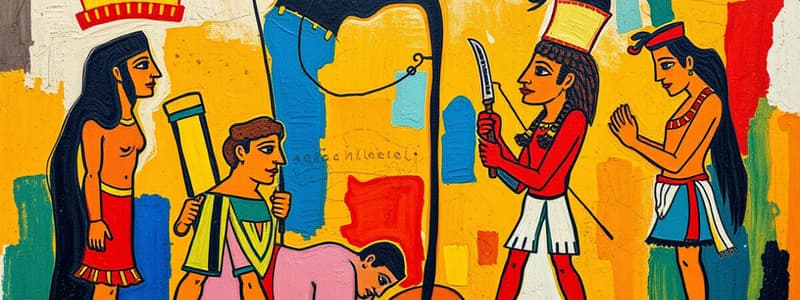Podcast
Questions and Answers
হোমো সেপিয়েন্স এর উদ্ভব কবে ঘটেছিল?
হোমো সেপিয়েন্স এর উদ্ভব কবে ঘটেছিল?
- 100,000 বছর আগে
- 300,000 বছর আগে (correct)
- 150,000 বছর আগে
- 500,000 বছর আগে
কোন সভ্যতা লিখনের উদ্ভব ঘটিয়েছিল?
কোন সভ্যতা লিখনের উদ্ভব ঘটিয়েছিল?
- চীন
- মিশর
- ভারতীয় উপমহাদেশ
- মেসোপটেমিয়া (correct)
গ্রীসে কোন ঘটনাটি ডেমোক্রেসির উদ্ভব ঘটায়?
গ্রীসে কোন ঘটনাটি ডেমোক্রেসির উদ্ভব ঘটায়?
- অথেন্স এবং স্পার্টার প্রতিযোগিতা (correct)
- আজকের সমাজবিজ্ঞানের উন্মেষ
- অথেন্সের স্বাধীনতা যুদ্ধ
- রোমান সাম্রাজ্যের পতন
ফিউডালিজমের উদ্ভব কোন সময়কে নির্দেশ করে?
ফিউডালিজমের উদ্ভব কোন সময়কে নির্দেশ করে?
রেনেসাঁসের সময়কালের গুরুত্বপূর্ণ ব্যক্তিত্বরা কোন শিল্পের উদ্ভাবক ছিলেন?
রেনেসাঁসের সময়কালের গুরুত্বপূর্ণ ব্যক্তিত্বরা কোন শিল্পের উদ্ভাবক ছিলেন?
এলেনাইটমেন্টের সময় কোন মূল নীতি বিশেষভাবে গুরুত্ব পেয়েছিল?
এলেনাইটমেন্টের সময় কোন মূল নীতি বিশেষভাবে গুরুত্ব পেয়েছিল?
শিল্প বিপ্লব কিভাবে সমাজে পরিবর্তনের সূচনা করেছিল?
শিল্প বিপ্লব কিভাবে সমাজে পরিবর্তনের সূচনা করেছিল?
বিশ্বযুদ্ধের প্রভাব কিসের উপরে সবচেয়ে বেশি ছিল?
বিশ্বযুদ্ধের প্রভাব কিসের উপরে সবচেয়ে বেশি ছিল?
Flashcards are hidden until you start studying
Study Notes
Prehistoric Era
- Emergence of Homo sapiens around 300,000 years ago.
- Development of tools, art, and language.
- Hunter-gatherer societies dominated until the Neolithic Revolution.
Ancient Civilizations
- Mesopotamia (c. 3500-500 BC): Birthplace of writing (cuneiform), agriculture, and urbanization (city-states like Ur and Babylon).
- Egypt (c. 3100-30 BC): Known for pyramids, hieroglyphics, and pharaohs; significant advances in medicine and engineering.
- Indus Valley (c. 2500-1500 BC): Urban centers like Harappa and Mohenjo-Daro; advanced drainage systems and trade networks.
- China (c. 2070 BC onwards): Dynastic cycles, Confucianism, Daoism; major inventions like paper and gunpowder.
Classical Antiquity
- Greece (c. 800-300 BC): Birthplace of democracy, philosophy (Socrates, Plato, Aristotle), and the Olympics; influential city-states: Athens and Sparta.
- Rome (c. 753 BC-476 AD): Expansion from a republic to an empire; contributions include law, engineering (aqueducts, roads), and Latin language.
Middle Ages (c. 500-1500 AD)
- Early Middle Ages: Feudalism, rise of Christianity, and Islamic Caliphates.
- High Middle Ages: Growth of towns, universities, and Gothic architecture.
- Late Middle Ages: The Black Death, decline of feudalism, and beginnings of the Renaissance.
Renaissance and Reformation (14th-17th Century)
- Renaissance: Rebirth of art, culture, and learning; emphasis on humanism; key figures include Leonardo da Vinci and Michelangelo.
- Reformation: Martin Luther's 95 Theses (1517) challenging Catholic Church practices; led to Protestantism.
Age of Exploration (15th-17th Century)
- European nations expand overseas; key explorers include Columbus, Magellan, and Vasco da Gama.
- Colonization of the Americas and global trade networks.
Enlightenment (18th Century)
- Intellectual movement emphasizing reason, individualism, and skepticism of authority.
- Key figures: Voltaire, Rousseau, Locke, and Montesquieu.
- Influenced revolutions (American and French).
19th Century
- Industrial Revolution: Transition to industrial economies; advancements in technology and transportation.
- Rise of nationalism and imperialism; notable events include the unification of Germany and Italy.
- Social changes: labor movements, women's rights, and abolition of slavery.
20th Century
- World Wars: WWI (1914-1918) and WWII (1939-1945); major political, social, and economic impacts.
- Cold War (1947-1991): Tension between the United States and the Soviet Union; nuclear arms race and proxy wars.
- Decolonization: End of colonial empires and emergence of new nations in Africa and Asia.
21st Century
- Globalization: Interconnected economies, cultures, and technologies; rise of the internet.
- Ongoing challenges: Climate change, terrorism, and political polarization.
- Advancements in technology: AI, biotechnology, and renewable energy sources.
প্রাক-ঐতিহাসিক যুগ
- হোমো স্যাপিয়েন্সের আবির্ভাব প্রায় ৩০০,০০০ বছর আগে ঘটে।
- অস্ত্র, শিল্প এবং ভাষার উন্নয়ন ঘটে।
- হান্টার-গ্যাদার সমাজটি নিউলিথিক বিপ্লব পর্যন্ত আধিপত্য করে।
প্রাচীন সভ্যতাসমূহ
- মেসোপটেমিয়া (প্রায় ৩৫০০-৫০০ BC): লিখনির্মাণের (কুনিফর্ম), কৃষি এবং নগরায়ণের জনক; গুরুত্বপূর্ণ নগররাষ্ট্রগুলো যেমন উর এবং বাবিলন।
- মিসর (প্রায় ৩১০০-৩০ BC): পিরামিড, হায়ারোগ্লিফিকস এবং ফারাওর জন্য পরিচিত; চিকিৎসা ও প্রকৌশলে উল্লেখযোগ্য অগ্রগতি।
- ইন্দু উপত্যকা (প্রায় ২৫০০-১৫০০ BC): হারাপ্পা ও মহেঞ্জোদারো মতো নগরকেন্দ্র; উন্নত শোধন ব্যবস্থা ও বাণিজ্য নেটওয়ার্ক।
- চীন (প্রায় ২০৭০ BC থেকে): রাজবংশের চক্র, কনফুসিয়ানিজম, এবং ডাওইজম; কাগজ ও বারুদের মতো গুরুত্বপূর্ণ উদ্ভাবন।
ক্ল্যাসিকাল প্রত্নতাত্ত্বিক যুগ
- গ্রিস (প্রায় ৮০০-৩০০ BC): গণতন্ত্র, দর্শন (সক্রেটিস, প্লেটো, অ্যারিস্টটল) এবং অলিম্পিকসের জন্মস্থান; উল্লেখযোগ্য নগররাষ্ট্র: এথেন্স এবং স্পার্টা।
- রোম (প্রায় ৭৫৩ BC-৪৭৬ AD): গণতন্ত্র থেকে সম্রাজ্যে সম্প্রসারণ; আইন, প্রকৌশল (অ্যাকুইডাক্ট, রাস্তা), এবং ল্যাটিন ভাষার অবদান।
মধ্যযুগ (প্রায় ৫০০-১৫০০ AD)
- প্রারম্ভিক মধ্যযুগ: সামন্ততন্ত্র, খ্রিষ্টধর্মের উত্থান, এবং ইসলামী খলিফাত।
- মধ্য মধ্যযুগ: শহরগুলির বৃদ্ধি, বিশ্ববিদ্যালয়গুলির প্রতিষ্ঠা, এবং গথিক স্থাপত্য।
- অবশেষ মধ্যযুগ: কালো মৃত্যু, সামন্ততন্ত্রের পতন, এবং রেনেসাঁরের সূচনা।
রেনেসাঁ ও ধর্ম সংস্কার (১৪শ-১৭শ শতাব্দী)
- রেনেসাঁ: শিল্প, সংস্কৃতি, এবং শিক্ষার পুনর্জাগরণ; মানবতাবাদের উপর emphasis; প্রধান ব্যক্তিত্ব: লিওনার্দো দা ভিঞ্চি এবং মাইকেলঅ্যাঞ্জেলো।
- ধর্ম সংস্কার: মার্টিন লুথার এর ৯৫টি থিসিস (১৫১৭) ক্যাথলিক গীর্জার অভ্যাসকে চ্যালেঞ্জ করে; প্রোটেস্টান্টিজমের জন্ম দিয়েছে।
অন্বেষণের যুগ (১৫শ-১৭শ শতাব্দী)
- ইউরোপিয়ান দেশগুলো সমুদ্রপৃষ্ঠে সম্প্রসারণ করে; প্রধান অনুসন্ধানকারীরা: কলম্বাস, মাগেলান, এবং ভাস্কো দা গামা।
- আমেরিকার কলোনীকরণ এবং বৈশ্বিক বাণিজ্য নেটওয়ার্ক।
আলোকময় যুগ (১৮শ শতাব্দী)
- যুক্তি, ব্যক্তিস্বাধীনতা এবং কর্তৃপক্ষের প্রতি সন্দেহের উপর ভিত্তি করে একটি বুদ্ধিবৃত্তিক আন্দোলন।
- প্রধান ব্যক্তিত্ব: ভলটেয়ার, রুসো, লক, এবং মণ্টেসকিউ।
- আমেরিকান ও ফরাসি বিপ্লবগুলিতে প্রভাব ফেলে।
১৯শ শতাব্দী
- শিল্পবিপ্লব: শিল্প ভিত্তিক অর্থনীতিতে পরিবর্তন; প্রযুক্তি ও পরিবहन উন্নয়ন।
- জাতীয়তাবাদ ও সাম্রাজ্যবাদ বাড়ে; জার্মানি ও ইতালির একতায় উল্লেখযোগ্য ঘটনা।
- সামাজিক পরিবর্তন: শ্রম আন্দোলন, নারীর অধিকার, এবং দাসত্বের বিলোপ।
২০শ শতাব্দী
- বিশ্বযুদ্ধ: WWI (১৯১৪-১৯১৮) ও WWII (১৯৩৯-১৯৪৫); রাজনৈতিক, সামাজিক এবং অর্থনৈতিক পরিবর্তন।
- শীতল যুদ্ধে (১৯৪৭-১৯৯১) মার্কিন যুক্তরাষ্ট্র ও সোভিয়েত ইউনিয়নের মধ্যে টানাপোড়েন; পারমাণবিক প্রতিযোগিতা ও প্রক্সি যুদ্ধ।
- উপনিবেশ-পূর্ব আবির্ভাব: উপনিবেশের সাম্রাজ্যগুলো শেষ হতে শুরু করে এবং আফ্রিকা ও এশিয়াতে নতুন জাতির উদ্ভব।
২১শ শতাব্দী
- বৈশ্বিকীকরণ: অর্থনীতি, সংস্কৃতি, এবং প্রযুক্তির আন্তঃসংযোগ; ইন্টারনেটের উত্থান।
- চলমান চ্যালেঞ্জ: জলবায়ু পরিবর্তন, সন্ত্রাসবাদ, এবং রাজনৈতিক বিভাজন।
- প্রযুক্তিতে অগ্রগতি: কৃত্রিম বুদ্ধিমত্তা, জীবপ্রযুক্তি, এবং নবায়নযোগ্য শক্তির উৎস।
Studying That Suits You
Use AI to generate personalized quizzes and flashcards to suit your learning preferences.




